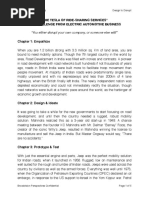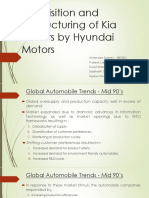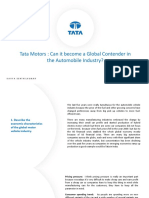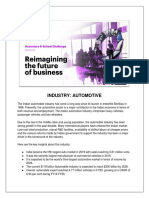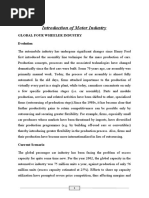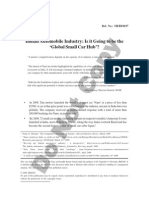Marketing Assignment
Marketing Assignment
Uploaded by
Mamuni PandaCopyright:
Available Formats
Marketing Assignment
Marketing Assignment
Uploaded by
Mamuni PandaCopyright
Available Formats
Share this document
Did you find this document useful?
Is this content inappropriate?
Copyright:
Available Formats
Marketing Assignment
Marketing Assignment
Uploaded by
Mamuni PandaCopyright:
Available Formats
Kia India Private Limited
is a subsidiary of Kia for its operations in India. The company was
founded on 19 May 2017 following an announcement of the construction of a new 536-acre
manufacturing facility in Anantapur District, Andhra Pradesh. The plant started its trial
production in January 2019 and the mass production of its first product, the Kia Seltos started
on 31 July 2019. The US$2 billion manufacturing plant is capable of producing 300,000 vehicles
annually.
Kia Motors India, the local arm of the Korean carmaker, sees sister brand Hyundai as a
competitor in the country, at least in the near to short term. In the long term, though, it has
ambitions to take a large pie in India’s passenger vehicle market together with Hyundai.
strategic challenge/s faced by the brand and the corresponding objectives set to be achieved
by the company
1) Big Barriers to Entry
For a long time, the Indian Auto industry has been an oligopoly, where the top two car-makers
hold more than 65% of the market (Maruti Suzuki at ~50%, and Hyundai at ~16-17%). The other
competitors have long found holding even 5% of the market as an ambitious target, and indeed,
many foreign car-makers hold less than 1% of the market despite being around for more than a
decade.
Understandably, therefore, competition in the lower half of the pyramid is intense. With
discount wars stretching the dealers thin, and tighter liquidity affecting the financing of cars,
the entry barriers move up another notch.
Internal Use - Confidential
While these huge barriers to entry loom, the Indian consumers and regulators have thrown
their own spanners into the works. Urban consumers, affected by worsening traffic conditions,
and the pains of finding safe and inexpensive parking spots, have chosen to place their trust in
ride-sharing and aggregator apps instead. There is also the growing trend of forgoing spending
on expensive depreciating assets in favour of expensive experiences – urban youngsters are
no longer as excited about ‘the first car’ as they were less than half a decade ago (though this
has recently been debated). In rural and small-town India, consumers are embattled by the
twin macroeconomic demons of farm distress and rising unemployment – they are naturally not
thinking of splurging on cars.
Meanwhile, regulators have chosen to skip BS-V norms and have decided to jump straight to
BS-VI in the coming years, forcing carmakers (Maruti Suzuki most recently) to re-evaluate their
diesel engines, and overall long-term strategy. Safety regulations like compulsory airbags on all
cars, while a welcome change, have surely affected the sales pitches of most carmakers. Earlier,
the sub-4-metre segment cars used to get away with 2 airbags as a premium feature –
something that will no longer be possible. And the mandatory safety requirements are a
laundry list – seatbelt reminders, speed warnings, manual overrides for central locking systems,
crash test compliance… the list is worrisome for Indian automakers who have often traded poor
safety standards for cost competitiveness. To top off the list, the government unveiled in 2017,
a grand ambition to convert India into an EV-only economy by 2030.
2) Big Slowdown Woes
Needless to say, with all this baggage, the Indian Auto industry is going through a slowdown of
problematic proportions. In the month of April, Y-o-Y car sales crashed by 17%, and reports
were circulated of this being the worst dip in the last 8 years. Then in May, sales crashed by
20%, making it arguably the worst dip the Auto Industry has ever faced.
Internal Use - Confidential
Out of the top 10 automakers in the country, 7 have been forced to either lower their operating
rates or take an actual shutdown for a few days in May-June.
3) Big Competition
The management at both Kia and MG have a very difficult task cut out for them. The only
segment that they can safely enter is sub-4-metre and 4+-metre, 5-seater SUVs – the only
segment where a new entrant can have some hope of fighting off the incumbents by swinging
customer opinions and hope for some growth during these tough times. Less than 5 years ago,
this segment was not really on people’s radars, but a few key launches have exploded this
market. The SUV segment has grown so fast that almost every major manufacturer has an
offering for the sub-4-metre segment post the launch of Hyundai Venue, something which has
only happened for hatchbacks before, and even there, not as uniformly as this.
Amongst the premium/4+-metre five-seaters, first the Hyundai Creta took the country by
storm, then the Jeep Compass took the country by storm, then the Tata Harrier tried the same
with limited success, and now the MG Hector as well as Kia’s SP2 wish to do the same. The less
successful incumbents include Renault’s Duster (which also had a successful launch but is stuck
in a rut now), and Captur, and Nissan’s Terrano and Kicks. The sub-4-metre segment is
consistently expected to draw some share away from these players. The premium sub-4-metre
cars often reach into the entry-level price bands of the 4+-metre cars, and with the facelifted
Ford Ecosport, Hyundai’s Venue and Mahindra’s XUV 3OO, there are now many lucrative
features on these cars (sometimes at a lower price-point) which may draw customers away
from the 4+-metre segment.
Internal Use - Confidential
4) Big Arsenals
For most of the Indian car consumers, and to a large extent, even for UVs, the car’s features
and engines work only towards drawing Attention and generating Interest. The final two stages
of ‘AIDA’ – the Decision and Action, are primarily driven by the Total Cost of Ownership (fuel
efficiency and resale value included), and the After Sales Service. While Kia is expected to
piggyback on Hyundai and will start with the largest network ever for a new entrant in India,
MG comes with the kind of deep pockets that only a “Big-Four” state-owned automobile
company from China can have. Kia’s preparedness may allay consumer concerns and MG’s
pockets may help it achieve in the Indian Auto Sector, what Chinese Smartphones achieved in
India’s Mobile Phone markets. But in my mind, the key to success still lies in building a brilliant
product, and clever marketing.
The Jeep Compass was launched in this country at a challenging price-point, and a rudimentary
sales and service network like any other new entrant. And yet, it was a success. The product
was amazing – the SUV had looks to die for, an engine that could set the roads on fire and a
good mix of features. The marketing was spot-on. Plus-sized billboards, a brilliant launch event,
amazing buzz creation by auto-enthusiasts and TVCs that wouldn’t make you change the
channel. The truth is that by virtue of price-points, the 4+-metre and sub-4-metre UVs target
the best possible Indian car buyer for a new entrant – one who will not be overly pragmatic or
utilitarian in their purchase and one who can be easily duped by good marketing into parting
with their significant disposable income.
Kia and MG have starte quite strong. MG gets Benedict Cumberbatch to endorse their product
in a post-Avengers: Endgame world.
Hyundai beat the Hector by a slim margin in becoming the first automaker to launch a
connected car, but MG’s features will still have a lot to sway the consumers and its design
language is already drawing the eyeballs. Kia has started with really quirky and fun ads which
draw attention, and the ‘well planned’ test runs of the SP2 on Mumbai roads has caused a lot of
buzz.
5)
§ Threat of Substitutes – In recent years, the influx of app-based ride-hailing cab services (Uber
& Ola) have become highly popular across cities in India, with on average 3.65 Mn rides per
day (refer Figure 1). These app-based cab services in recent years have emerged as substitute
for car ownership- for many consumers, and have affected a portion of car sales in the country.
With Uber and Ola in the fray, many consumers have found it to be comparatively easier to use
such services rather than buying/owning their own cars, which they consider cumbersome.
Figure1: Number of Ola/Uber rides per day and Y-o-Y Growth
Internal Use - Confidential
Source: Economic Times
6)
§ Competitive Rivalry – Competitive rivalry is extremely high in India, the 4th largest automotive
market in the world, and already 7th largest manufacturer of commercial vehicles, and a key
net exporter- with automobile exports having grown 14.5% during FY 2019
7)
§ Bargaining Power of Suppliers – The Indian the automotive components industry is a mature
one and has witnessed high growth during 2014 to 2019, at a CAGR of 10.1% to reach $56.5 Bn
in FY19, and exports of $15.2 Bn. Bargaining power of suppliers is moderate as they also need
automobile manufacturers and consumers to grow their business and ensure growth.
8)
§ Bargaining Power of Buyers – In a challenging and slowdown impacted automotive
environment in India, bargaining power of buyers has certainly gone up. Various manufacturers
have been witnessed to be doling out large discounts (often to the tune of Rs. 40,000 to Rs.
50,000) and extended warranty features – to lure the ‘price-sensitive Indian consumer’ during
festive months such as Diwali.
7) List Of Problems That Are Being Faced By Kia Seltos Owners
Internal Use - Confidential
The list of problems faced by Kia Seltos owners includes late delivery, poor servicing and poor
quality of the components used onboard.
Kia Seltos is currently one of the most popular SUVs in India. Priced starting at Rs 9.69 Lakhs up
to Rs 16.99 Lakhs (Ex-showroom), it has already made it to the top-selling cars list for the past
two months.
The bookings have crossed over 60,000 units in just months of it being launched. The waiting
period, however, is in much control, as the maximum that you have to wait is up to 3 months.
Its price-rival MG Hector, had a waiting period of over a year.
On the other hand, many owners of the SUV have taken their problems on social media. The
problems regarding Kia Seltos have been faced by many buyers, which have been clubbed
ahead.
1. Overheating of Transmission
Many buyers have complained that they are getting a message on the MID that says
“Transmission temperature is high. Stop Safely”. One buyer drove the Seltos GTX+ for around
100 kms and then he got the overheating message on the MID. Another buyer who has the DCT
variant has experienced the same problem in just a couple of weeks of purchase.
2. Delivery of a defective car
An owner of Kia Seltos Diesel HTK 6-speed AT has discussed her problems. In the long post, she
said that in just 20 days of buying, the infotainment started going off. While hopping from
dealer to dealer, she finally managed to get the car fixed after 2-3 days. However, in just some
time of driving again, the problem came again. Then the owner also experienced the white
smoke and bad smell coming from the AC. All these problems are being faced in just 20 days of
the car being purchased.
3. No response for an accident-affected car
Many users are facing trouble with the Kia service centres. One owner got into an accident
within 3 days of buying the car. However, it has been over 2 months without any response from
the Kia service centre, about the affected car. Similarly, another buyer has his Seltos parked at
the service centre for 15 days because there are no spare parts and decent customer service
available.
Internal Use - Confidential
4. Wrong Delivery Time Period
A lot of buyers have complained that they have still not received their Seltos till now. For one
buyer, it has been over 100 days since he booked the GTX DCT variant and there is no update
about the delivery. Another person has the same issue and it has been 93 days since the
booking. The buyers think that there is a preference system going on with the Kia dealerships.
5. Low Mileage
One specific owner has claimed that despite driving for over 450 kms on a traffic-free road and
at a speed of 40 km/hr, the mileage of the GTX DCT is just 7.7 kmpl. Also, the person was
constantly driving on the ECO mode and despite that, low mileage. The company claims to offer
16 kmpl with the DCT variant.
Internal Use - Confidential
You might also like
- Kia Motors: Positioning and Growth Strategies in IndiaDocument7 pagesKia Motors: Positioning and Growth Strategies in IndiaAmmar AhmadNo ratings yet
- VW T5 2009 2014 Fuse BoxesDocument13 pagesVW T5 2009 2014 Fuse BoxesStelian BaciuNo ratings yet
- Kia Motors Case Analysis: Q-1 PORTERS 5 Forces ModelDocument6 pagesKia Motors Case Analysis: Q-1 PORTERS 5 Forces ModelKunika Agarwal0% (1)
- Porter's Five Forces AnalysisDocument7 pagesPorter's Five Forces AnalysisVinayak Arun SahiNo ratings yet
- Market Potential For Hyundai VernaDocument10 pagesMarket Potential For Hyundai VernaFarhaan MohammedNo ratings yet
- Factors Affecting Demand Supply of Automobile IndustryDocument7 pagesFactors Affecting Demand Supply of Automobile IndustryNalin Gupta83% (23)
- Buying Behaviour of Car ReportDocument36 pagesBuying Behaviour of Car ReportNikunj WaliaNo ratings yet
- Marketing Strategy of Maruti SuzukiDocument87 pagesMarketing Strategy of Maruti SuzukiSaurabh Lohal82% (17)
- Maruti Suzuki Industry Profile&Company ProfileDocument34 pagesMaruti Suzuki Industry Profile&Company ProfileSudheer Nani100% (3)
- KIA Strategic ManagementDocument6 pagesKIA Strategic ManagementAbhijit SinghNo ratings yet
- Kia Motors Case StudyDocument6 pagesKia Motors Case StudyAmmar Ahmad100% (3)
- Analysis of Automobile IndustryDocument13 pagesAnalysis of Automobile IndustryShubhanshu SharmaNo ratings yet
- Mahindra Automotive Business - Ride Sharing BusinessDocument5 pagesMahindra Automotive Business - Ride Sharing BusinessSubin Suresh BabuNo ratings yet
- Reinventing The Wheel, For The PeopleDocument4 pagesReinventing The Wheel, For The PeopleAjith ReddyNo ratings yet
- Report On Hyundai I20Document10 pagesReport On Hyundai I20Sandarbh AgarwalNo ratings yet
- Penilaian PiyushDocument7 pagesPenilaian PiyushScribdTranslationsNo ratings yet
- Project Marketing Strategy of Maruti SuzukiDocument38 pagesProject Marketing Strategy of Maruti SuzukiJalesh mehta100% (1)
- Sector Project - 1 Comparitive Analysis of The Automotive Industry Based On Porter'S 5 Force ModelDocument19 pagesSector Project - 1 Comparitive Analysis of The Automotive Industry Based On Porter'S 5 Force ModelLakshanthNo ratings yet
- London-SAM Mba-112 International Marketing StrategyDocument18 pagesLondon-SAM Mba-112 International Marketing StrategyBhaveshkumar BhanderiNo ratings yet
- Survival Game or Shifting the Gear the Kia Motors in IndiaDocument9 pagesSurvival Game or Shifting the Gear the Kia Motors in IndiaTolony TukkuNo ratings yet
- Project Report On Maruti Showroom Manage - 230914 - 115759Document92 pagesProject Report On Maruti Showroom Manage - 230914 - 115759vishal birajdarNo ratings yet
- Car Service MfsDocument37 pagesCar Service MfsTarun KapoorNo ratings yet
- Demand Analysis & Forecasting - The Car Industry: Presented byDocument31 pagesDemand Analysis & Forecasting - The Car Industry: Presented byprerna_bafnaNo ratings yet
- Hyundai SantroDocument80 pagesHyundai Santrob6_50258983050% (2)
- JBMDocument53 pagesJBMVaibhav Ahlawat100% (1)
- Statement of ProblemDocument5 pagesStatement of ProblemNazim Sha100% (1)
- A Nano Car in Every Driveway PDFDocument8 pagesA Nano Car in Every Driveway PDFAshwani MattooNo ratings yet
- I. Dilemma of The Case/AbstractDocument11 pagesI. Dilemma of The Case/AbstractAnindya BasuNo ratings yet
- Competitor Analysis of Tata MotorsDocument9 pagesCompetitor Analysis of Tata MotorsDevanshi AroraNo ratings yet
- Copy HyundaiDocument73 pagesCopy HyundaiNiki KajalNo ratings yet
- Project Report On Why Does India Need A Small Car Like NanoDocument17 pagesProject Report On Why Does India Need A Small Car Like Nanoshaziatabassum9No ratings yet
- Chapter-1: Industry Profile Automotive IndustryDocument49 pagesChapter-1: Industry Profile Automotive IndustryNischal PrasannaNo ratings yet
- Hyundai CompanyDocument80 pagesHyundai CompanySandeep SinghNo ratings yet
- Case Study On Brand WagonR FINALDocument6 pagesCase Study On Brand WagonR FINALDheeraj BharadwajNo ratings yet
- Hyundai Creta - MadanDocument12 pagesHyundai Creta - Madanmadanmohanreddynukaraju74No ratings yet
- Project Report On Maruti Showroom ManagementDocument92 pagesProject Report On Maruti Showroom Managementneoratm100% (1)
- Final ProjectDocument15 pagesFinal Projecttrisanka banikNo ratings yet
- You Either Disrupt Your Own Company, or Someone Else Will!Document5 pagesYou Either Disrupt Your Own Company, or Someone Else Will!vidhiNo ratings yet
- Ravi Final 2022Document74 pagesRavi Final 2022Deepak DeepuNo ratings yet
- Case Study: KIA Motors in INDIA - Will It Survive or Will It Fail..Document11 pagesCase Study: KIA Motors in INDIA - Will It Survive or Will It Fail..kirandeep kaurNo ratings yet
- Marketing ManagementDocument17 pagesMarketing ManagementPriyanshu Gupta100% (1)
- Strategic Management in Auto Mobile IndustryDocument10 pagesStrategic Management in Auto Mobile IndustryVikramaditya ReddyNo ratings yet
- Acquisition and Merger of Kia Motors by Hundai Motors Rev 1.0Document13 pagesAcquisition and Merger of Kia Motors by Hundai Motors Rev 1.0Tejaswi Monangi100% (1)
- SWOT Analysis of Automobile IndustryDocument12 pagesSWOT Analysis of Automobile IndustryDev GoelNo ratings yet
- Automobile Industry ProjectDocument12 pagesAutomobile Industry ProjectAyanava0% (1)
- Tata Motors Case StudyDocument12 pagesTata Motors Case StudyPrabhakar Manoharan0% (1)
- Automobiles Sector ReportDocument9 pagesAutomobiles Sector ReportNihar AkunuriNo ratings yet
- Indian Small Car Industries (Case Study) : Maruti Udyog Limited (MUL)Document4 pagesIndian Small Car Industries (Case Study) : Maruti Udyog Limited (MUL)Hemant BothraNo ratings yet
- Automotive FinalDocument3 pagesAutomotive FinalmohiniNo ratings yet
- Maruti Udyog LimitedDocument125 pagesMaruti Udyog LimitedSainiJaspreetkaurNo ratings yet
- India - Global Small Car HubDocument26 pagesIndia - Global Small Car HubSaurabh BishtNo ratings yet
- BC 3 Hyundai ReportDocument27 pagesBC 3 Hyundai ReportHà NguyễnNo ratings yet
- A Study On The Marketing Mix Strategies of Mercedes BenzDocument29 pagesA Study On The Marketing Mix Strategies of Mercedes BenzMurphy JimmonsNo ratings yet
- Marketing Strategy of Maruti SuzukiDocument88 pagesMarketing Strategy of Maruti SuzukiApoorva KohliNo ratings yet
- MRP_VIshal NIrgudeDocument12 pagesMRP_VIshal NIrgudevishalnirgude7No ratings yet
- Enterprise Management Automobile Industry Business Cases: Renault Morocco, Tesla, Hyundai, TATA Motors, Daimler Mobility, ToyotaFrom EverandEnterprise Management Automobile Industry Business Cases: Renault Morocco, Tesla, Hyundai, TATA Motors, Daimler Mobility, ToyotaNo ratings yet
- Challenges Faced by KiaDocument2 pagesChallenges Faced by KiaMamuni PandaNo ratings yet
- Internal Use - ConfidentialDocument8 pagesInternal Use - ConfidentialMamuni PandaNo ratings yet
- Indian Automotive Sector Growth ProspectDocument6 pagesIndian Automotive Sector Growth ProspectMamuni PandaNo ratings yet
- Intro To Accouting and Financial StatementsDocument7 pagesIntro To Accouting and Financial StatementsMamuni PandaNo ratings yet
- AW Transactions To Balance SheetDocument1 pageAW Transactions To Balance SheetMamuni PandaNo ratings yet
- Besf1ts Part ListDocument92 pagesBesf1ts Part Listtito10332No ratings yet
- Spirax s5 Atf XDocument3 pagesSpirax s5 Atf XElectro killNo ratings yet
- Honda Accord Sedan 2005 Owner ManualDocument297 pagesHonda Accord Sedan 2005 Owner ManualAdrián SchelottoNo ratings yet
- RestraintsDocument658 pagesRestraintsSideth ChivNo ratings yet
- Lista de Precios Actualizada 11-03-2024 (Mercancia Nueva)Document111 pagesLista de Precios Actualizada 11-03-2024 (Mercancia Nueva)maikolNo ratings yet
- Shock AbsorbersDocument58 pagesShock AbsorbersKattie ValerioNo ratings yet
- Detroit Diesel: Series I900Document53 pagesDetroit Diesel: Series I900Jose SantosNo ratings yet
- TOYOTA Corolla ZRE152R 1.8 Litre 2ZR-FE Eng. (2007-2013)Document5 pagesTOYOTA Corolla ZRE152R 1.8 Litre 2ZR-FE Eng. (2007-2013)Juan AriasNo ratings yet
- ENGINE OIL CAPACITY 2Document2 pagesENGINE OIL CAPACITY 2Godwin NkwoNo ratings yet
- Full Kits.... 2019.......Document7 pagesFull Kits.... 2019.......Leiker LdhfNo ratings yet
- buyleadreports2024-12-10 09_18_04Document13 pagesbuyleadreports2024-12-10 09_18_04gaddam.kohilNo ratings yet
- Cardata 1Document423 pagesCardata 1Marian-Ionut IvanovNo ratings yet
- MA-PX Ranger Body Repair Summary - LRDocument20 pagesMA-PX Ranger Body Repair Summary - LRSonny Jendhool Setyawan0% (2)
- LIC Private Hire Vehicles Public Register SepDocument33 pagesLIC Private Hire Vehicles Public Register SepАлексей КанарикNo ratings yet
- Auto Week #2Document1 pageAuto Week #2Caseydb6No ratings yet
- UNIVERSAL JOINT CatalogueDocument34 pagesUNIVERSAL JOINT CatalogueRepuestos Maxicar100% (2)
- 2007 Buick RendezvousDocument528 pages2007 Buick RendezvousJohnny jonesNo ratings yet
- AmbalaDocument22 pagesAmbalaHirdesh AroraNo ratings yet
- SSA Parts Price ListDocument17 pagesSSA Parts Price ListmaxmurshidNo ratings yet
- Situatia Autorizatii Taxi 20230821Document546 pagesSituatia Autorizatii Taxi 20230821Ana LoweNo ratings yet
- G100, G101, G102, G103, and G104: - Document ID: 2082653Document6 pagesG100, G101, G102, G103, and G104: - Document ID: 2082653thedios100No ratings yet
- Citroën C5: Quickstart GuideDocument18 pagesCitroën C5: Quickstart GuideLeandro MesquitaNo ratings yet
- 2021 07 Vietnam Vinfast Electric Cars EuropeDocument2 pages2021 07 Vietnam Vinfast Electric Cars EuropeMishaNo ratings yet
- Japanese Vehicle List PDFDocument65 pagesJapanese Vehicle List PDFalberto cortesNo ratings yet
- Hyundai StrategyDocument7 pagesHyundai StrategyAlex PutuhenaNo ratings yet
- Geely Takes Stake in German Flying Taxi Start-Up Volocopter - Financial TimesDocument2 pagesGeely Takes Stake in German Flying Taxi Start-Up Volocopter - Financial TimesMaria BordognaNo ratings yet
- Lucas Alternator CatalogueDocument189 pagesLucas Alternator CatalogueNeftali RosalesNo ratings yet
- Polaris Sportsman 500 Starter - Wiring Diagram Collection - Polaris Ranger, Polaris RZR, Polaris AtvDocument1 pagePolaris Sportsman 500 Starter - Wiring Diagram Collection - Polaris Ranger, Polaris RZR, Polaris AtvEgidijus JancevičiusNo ratings yet
- Turbocharger Kit PartsDocument257 pagesTurbocharger Kit PartsMuhammad Rizki100% (1)





































